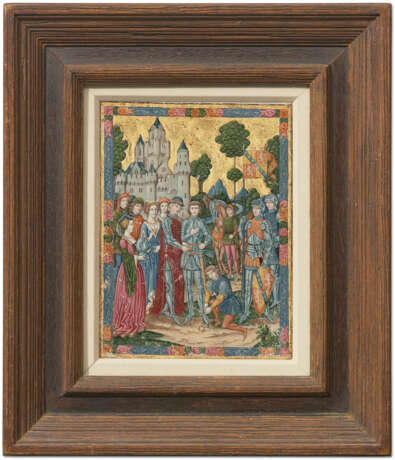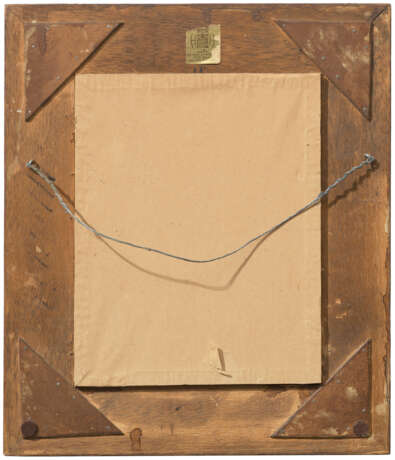ID 1360853
Lot 137 | The Dressing of a Knight
Valeur estimée
$ 5 000 – 8 000
A chivalric scene by one of the great forgers of the modern age.
260 × 197mm by sight; 454 × 390mm overall. The miniature depicting a knight being dressed for battle (some creasing, craquelure to the burnished gold, and a few small losses of pigment). Mounted and framed.
lllumination:
Playing on late-medieval themes of chivalry, this miniature is typical of the Spanish Forger, a painter and illuminator active in Paris from the end of the 19th century to the beginning of the 20th century. A vibrant palette of blues, pinks, reds, and greens mimic the appearance of late medieval illumination, yet the Forger’s use of green copper arsenite (synthesized 1814), ultramarine blue (synthesized 1828) and Scheele’s green (synthesized 1775) reveal it to be a 19th-century imitation. The composition – a knight being dressed for battle – was a favored design by the Forger: an almost identical scene from the collection of Dr Sylvia Legrain was sold in Zurich at Koller, 20 September 2023, lot 1931.
Unmasked in 1930 by Belle da Costa Greene, then director of the Pierpont Morgan Library, the Spanish Forger is known today as one of the "most skillful, successful, and prolific forgers of all time." He takes his misleading name, the Spanish Forger, from a false attribution of a painting once thought to be by a 15th-century Spanish artist. The name has stuck. Despite the growing evidence that the Forger supervised an atelier in Paris (remnants of old Parisian newspapers have been found inside the frames), no trace of his real identity has come to light. Hundreds of works are attributed to him, and in 1978 a retrospective exhibition of his art was organized at the Pierpont Morgan Library in New York and revisited again with an exhibition in 2014 at the Binghamton University Art Museum. His work is of great interest to both private collectors and museums: in 2009 the Victoria and Albert Museum in London acquired five paintings by the Spanish Forger "for what they tell us about late 19th-century perceptions of the Middle Ages."
The Forger was active already in the 1890s and he was still painting in the 1920s. He borrowed freely from chromolithographic editions published in Paris for his compositions, especially the series of publications by Lacroix, which suggests that he was likely employed by the Parisian publishing house Firmin Didot. His work capitalized on the vogue for medieval miniatures and cuttings and for the general popularity of medieval art revitalized by the Neogothic and Arts and Crafts movements. While the Forger attempted to imitate medieval painting, the artist had his own style with unique faces, peculiarities of architecture, and use of perspective. In his study of the artist, William Voelkle indicates that the Forger altered and then restored his own work in order to make it appear more authentic while often painting on reused vellum from the 14th and 15th centuries (W. Voelkle and R.S. Wieck, The Spanish Forger, New York, 1978). These characteristics are all present in this miniature.
| Lieu d'origine: | France |
|---|---|
| Catégorie maison de vente aux enchères: | Manuscrits médiévaux et de la Renaissance |
| Lieu d'origine: | France |
|---|---|
| Catégorie maison de vente aux enchères: | Manuscrits médiévaux et de la Renaissance |
| Adresse de l'enchère |
CHRISTIE'S 20 Rockefeller Plaza 10020 New York Etats-Unis | ||||||||||||||
|---|---|---|---|---|---|---|---|---|---|---|---|---|---|---|---|
| Aperçu |
| ||||||||||||||
| Téléphone | +1 212 636 2000 | ||||||||||||||
| Fax | +1 212 636 4930 | ||||||||||||||
| Conditions d'utilisation | Conditions d'utilisation | ||||||||||||||
| transport |
Service postal Service de messagerie ramassage par vous-même | ||||||||||||||
| Modes de paiement |
Virement bancaire | ||||||||||||||
| Heures d'ouverture | Heures d'ouverture
|




